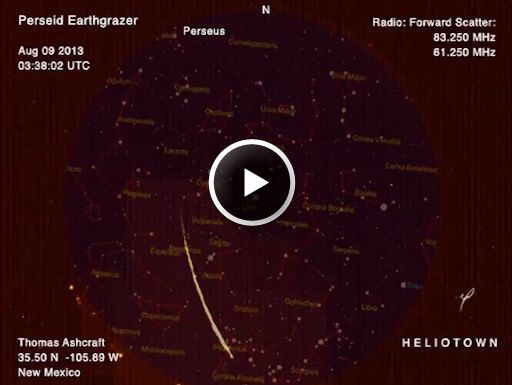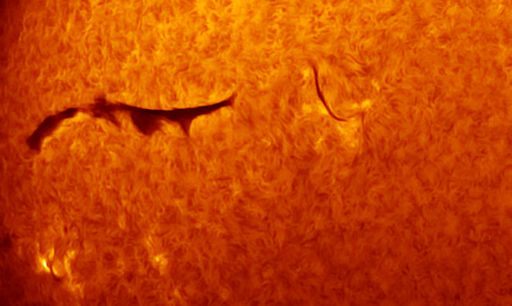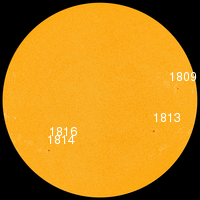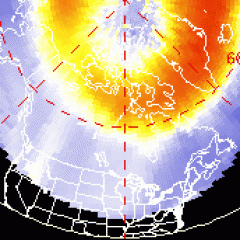CHANCE OF STORMS: NOAA forecasters estimate a 60% chance of polar geomagnetic storms on August 10-11 when one and perhaps two CMEs are expected to hit Earth's magnetic field. The incoming clouds were propelled from the sun by a flurry of erupting magnetic filaments on Aug. 6-7. High-latitude sky watchers should be alert for auroras. Aurora alerts: text, voice.
PERSEID EARTHGRAZER: Last night a bright meteor skimmed the top of Earth's atmosphere over rural New Mexico, passing almost directly above the private observatory of amateur astronomer Thomas Ashcraft. Wide-field cameras and radio receivers captured the flight of this Perseid earthgrazer:
Play the movie again and listen to the soundtrack. The eerie-sounding echoes are caused by terrestrial TV signals bouncing off the meteor's ionized trail. "In the radio meteor community, Perseids are known as 'blue whizzers' due to their fast speed and zinging radio reflections," notes Ashcraft.
More Earthgrazers are in the offing. Every night, Earth is plunging deeper into the debris stream of comet 109P/Swift-Tuttle, source of the annual Perseid meteor shower. The best time to look for earthgrazers is between 9:30 and 10:30 pm local time as the shower's radiant climbs over the northeastern horizon. That's when the geometry favors meteoroids skimming across the top of the atmosphere like a stone skipping across the surface of a pond. Earthgrazers are slow and colorful. (Regular non-Earthgrazing Perseids, on the other hand, are best seen after midnight.)
Forecasters expect the 2013 Perseid meteor shower to peak on the nights of August 12-13 with as many as ~100 meteors per hour. Stay tuned!
DARK FILAMENT: The biggest dark mark on the sun today is not a sunspot, it's a magnetic filament. Measuring more than 300,000 km from end to end, and filled with cool plasma, the sprawling structure is an easy target for backyard solar telescopes. Sergio Castillo sends this photograph from Inglewood,CA:
"Most likely this filament will collapse," predicts Castillo. "The question is, how long it will last until it does?"
If the filament does collapse (a big IF), it could crash into the stellar surface and produce a Hyder flare. That may be the only chance of flares on the sun today. Although there are four numbered sunspot groups on the Earthside on the sun, none of them has a complex magnetic field that harbors energy for strong explosions. Aside from filaments, solar activity is low.

Solar wind
speed: 416.5 km/sec
density: 0.3 protons/cm3
explanation | more data
Updated: Today at 1556 UT
X-ray Solar Flares
6-hr max: B4 1227 UT Aug10
24-hr: B4 1227 UT Aug10
explanation | more data
Updated: Today at: 1500 UT
![]()
Daily Sun: 10 Aug 13
None of these sunspots poses a threat for strong solar flares. Credit: SDO/HMI
![]()
Sunspot number: 51
What is the sunspot number?
Updated 10 Aug 2013
Spotless Days
Current Stretch: 0 days
2013 total: 0 days (0%)
2012 total: 0 days (0%)
2011 total: 2 days (<1%)
2010 total: 51 days (14%)
2009 total: 260 days (71%)
Since 2004: 821 days
Typical Solar Min: 486 days
Update 10 Aug 2013
The Radio Sun
10.7 cm flux: 104 sfu
explanation | more data
Updated 10 Aug 2013
![]()
Current Auroral Oval:
Switch to: Europe, USA, New Zealand, Antarctica
Credit: NOAA/POES
![]()
Planetary K-index
Now: Kp= 2 quiet
24-hr max: Kp= 2 quiet
explanation | more data
Interplanetary Mag. Field
Btotal: 5.1 nT
Bz: 3.2 nT north
explanation | more data
Updated: Today at 1556 UT
![]()
Coronal Holes: 10 Aug 13
A coronal hole is emerging over the sun's NE limb. Credit: SDO/AI






